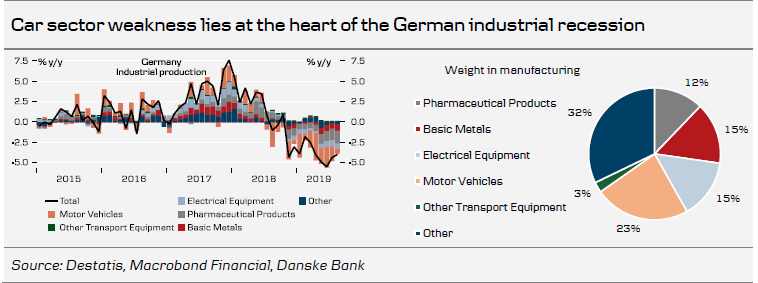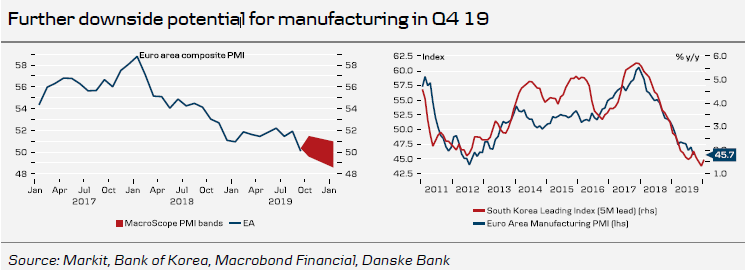As the euro surprise index closes in on the lows reached at the start of the year (as we anticipated in Euro Area Research – Catching up with reality, 27 June), the focus in the market continues to centre on the protracted manufacturing recession and when a potential trough may finally be reached. Although weaker manufacturing activity is a global phenomenon, the euro area has experienced by far the largest collateral damage from the rougher global trade environment. In this publication we take a closer look at the drivers and outlook for the euro area manufacturing cycle, focusing especially on Germany which has been at the epicentre of the slowdown. In sum, we find evidence that things could start to brighten up in 2020, but a strong rebound is difficult to see and event risk remains elevated.
A broad-based slump in industry
Starting with looking at the drivers, a recent ECB study finds that the fall in euro area industrial production has both been driven by the intensification of global trade tensions and domestic developments. Whereas weakness in international trade was the main contributor to the fall in production in H1 18, since Q3 18 euro area specific developments also played a major role and contributed 63% of the fall in euro area industrial production growth. Much of these had their roots in Germany, but countries with close interlinkages to German industry – such as Italy – have also not been left unscathed.
The decomposition of German industrial production growth reveals that the car sector has been the major driver, also because of the importance of the industry for the German economy, constituting almost a quarter of the weight in manufacturing GVA. Together with a decline in pharma production, the weaker activity in the car sector can explain some two thirds of the slump in industrial production. However, it is fair to say that Germany is suffering from a broad-based industry weakness these days, with few sectors still registering positive production growth at the moment.

Order-inventory dynamics: trade war uncertainty is working its way through the supply chain
A slump in new orders has been a major driver for the decline in production. But – in line with the ECB’s findings – the dynamics in the orders weakness have changed: while the decline in new orders in 2017-18 was mainly driven by foreign markets, the weakness in late-2018 and 2019 is more due to falling domestic orders – an indication that domestic factors related to the car sector continue to play a role, but also that the effect of trade war uncertainty is working its way through the supply chain. This is also corroborated when looking at different goods categories. While intermediate goods producers have been hardest hit from weakening new orders due to their connection to global supply chains, lately we have also seen spill-overs to capital and even consumer goods orders, in a sign that the investment cycle is turning and consumers have become more cautious.
Despite the slump in orders, capacity utilisation in manufacturing remains relatively high at 83.9% and in line with its long-term average. This puzzle could be explained by the fact that order books are still relatively well stocked from previous years and firms are currently replenishing their stocks, indicated by the rising inventory levels. However, there is a limit on how much production can be front-loaded and PMIs point to further declines in capacity utilisation ahead. Both will be factors weighing on industrial production in our view.
Car industry: light at the end of the tunnel?
A switch to new emission test procedures (WLTP) triggered a collapse in car production by over 20% since mid-2018. Since then bottlenecks have abated, but the predicted rebound in production has yet to materialise. Both cyclical as well as structural factors are probably to blame. The production slump was preceded by a multi-year phase of strong sales that would have been difficult to sustain under growing capacity constraints anyway. However, driving bans on diesel cars in a growing number of German cities and shifting consumer preferences towards electric and hybrid cars, where Volkswagen (DE:VOWG_p), Daimler, BMW and co. have long remained dormant, are also part of the explanation.
The continued slump in car production is somewhat at odds with the increase in car registrations observed since Q1 19. Both a recent rebound (+18.5% m/m in August) in domestic new orders and a run-down of inventories from strong sales would point to an improved outlook for car production in 2020. That said, export expectations remain subdued in a sign that foreign demand remains an issue and the order-inventory balance points to further contraction in output near-term. All this leaves us sceptical about expecting a strong rebound in car production in 2020.

Pharma industry drag is fading in Q4 19
In contrast to the ongoing struggles of the car sector, the negative contribution from the pharma industry to the industry slump seems more to arise from one-off rather than cyclical factors. In 2018 the production index saw an artificially strong increase on the back of production relocations for a valuable medicine. In Q4 18 production slumped, also exacerbated by the low water-levels in the Rhine river. As water levels have normalised, production has gradually recovered in 2019 and the Ifo business climate indicator for the industry remains robust. Overall, the downward pressure from base effects will diminish from Q4 19, which could give a slight (statistical) boost to the annual growth figures in industrial production.
Industry weakness broadens out to other sectors
Although the car sector may be on a sluggish path of recovery and the drag from pharma production is fading, signs are growing that German industry weakness is spreading. The slump in output of basic metal products and electrical appliances has its origin in both spill-overs effects from a struggling car sector as well as a deteriorating trade environment and waning global demand. As we do not believe in a strong rebound in the car sector nor a material improvement in the global trade environment in the near-term, we expect the drag from these sectors to persist or even worsen – a message that is corroborated by the Ifo business climate indicator.
Euro area manufacturing cycle to trough in early 2020, but event risk still high
So where does that leave us with respect to the German – and for that matter – euro area manufacturing cycle? Times remain challenging and in sum we see further downside potential for manufacturing in Q4 19 (with euro area PMI manufacturing stabilising around 45.0). Our quantitative business cycle model MacroScope, 17 September, (which foresees further euro area weakness ahead), falling global trade volumes and a range of other leading indicators, such as the still negative order-inventory balance, all support this view. Going into 2020, we expect the European manufacturing slump to bottom out (with PMI manufacturing entering on a gradual path of recovery) helped by a sluggish normalisation in car production, the waning drag from the pharma base effects as well as positive spill-overs from an expected rebound in the Chinese manufacturing cycle.

That said, event risk remains high, as the recent escalation in the EU-US tariff dispute over illegal Airbus subsidies has shown. Although the magnitude of US tariff increases authorised by the WTO is still relatively small at USD7.5bn, it will hit one of the countries (France) and sectors (airplane parts) which so far have been fairly resilient to the European industry slump. In that light further US tariff escalations – be it with Europe or China – as well as a chaotic No-deal Brexit remain prominent downside risks.
